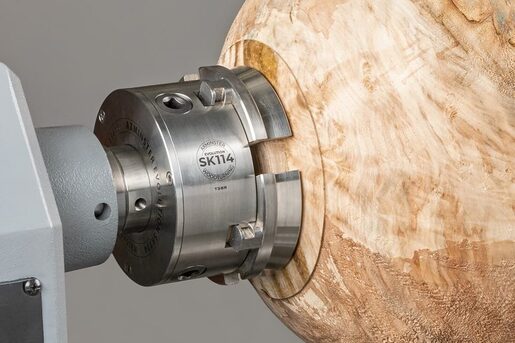Learn from the bestGo to YouTube and search "woodturning." You'll get more results than the wood shavings from a 12" bowl. Generally as a cure for insomnia, I keep finding good stuff all the time. Here's a selection of my current favorites:
Step-by-step guideTurning a bowl involves a number of steps. To stay on track, you might want to use this list as a cheat sheet. (Note: We're starting with your wood blank already on a chuck, which we'll cover in a future lesson.)
What you'll use: lathe, chuck, and cutting toolsWhen you make a bowl, you're using a lathe to spin a piece of wood attached to the lathe by a chuck while using cutting tools to shape the bowl. This process is referred to as "turning a bowl." And you are about to become a "wood turner." 1. Lathe spins the wood for cuttingThis diagram covers the key components of a wood lathe. This introductory video shows how the lathe works. 2. Chuck attaches the bowl to the latheThe chuck holds your wood on the lathe's headstock while you're turning the bowl. Most beginners start with a wooden chuck, as shown in the first photo below. If you start making a lot of bowls, you'll find it helpful to have a metal chuck you can use over and over. 3. Cutting tools shape the bowlThere are three major categories of cutting tools: scrapers, bowl gouges, and carbide-tipped cutters, each with pros and cons. In our class, we use scrapers supplied by the shop. This video digs into the differences between the three types of tools and the pros and cons of each.
Three places to get woodThanks to a generous gift from a prior Gold Canyon resident, we can supply the wood you need to make your first bowl. If you continue with this hobby, you'll need to get your own wood. You'll have three options:
1. Milled construction lumber, such as pine from Home Depot. You won't see this used as much in our woodshop, but it's a terrific way to get started, in fact, that's what the instructor uses in the Turn your first bowl video. And this video gives tips on using this inexpensive option. 2. Milled lumber from specialty stores: This is generally hardwood such as maple and walnut, as well as more exotic woods such as padauk and zebra wood. 3. Logs from a variety of sources, such as tree maintenance companies. In Arizona, it's not too hard to find local woods such as mesquite. Unlike lumber, this raw wood needs to be dried for about a year (it varies by size and type of wood) before you'll want to make a bowl with it. Wet wood, also called green wood, can be used, but your bowl will change shape and possibly crack as it dries. Safety essentialsThe least you need to know:
* How to turn the lathe on and off * How to choose the right speed for the lathe to turn * How to use the tool rest * How to safely use each cutting tool (gouge, scraper, and parting tool) That's the short list. Here's a long one from the Canadian Centre for Occupational Safety.
|
Archives |





